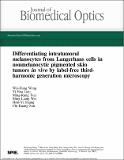| dc.contributor.author | Weng, Wei-Hung | |
| dc.contributor.author | Liao, Yi-Hua | |
| dc.contributor.author | Tsai, Ming-Rung | |
| dc.contributor.author | Wei, Ming-Liang | |
| dc.contributor.author | Huang, Hsin-Yi | |
| dc.contributor.author | Sun, Chi-Kuang | |
| dc.date.accessioned | 2016-11-03T21:11:13Z | |
| dc.date.available | 2016-11-03T21:11:13Z | |
| dc.date.issued | 2016-07 | |
| dc.date.submitted | 2015-12 | |
| dc.identifier.issn | 1083-3668 | |
| dc.identifier.issn | 1560-2281 | |
| dc.identifier.uri | http://hdl.handle.net/1721.1/105192 | |
| dc.description.abstract | Morphology and distribution of melanocytes are critical imaging information for the diagnosis of melanocytic lesions. However, how to image intratumoral melanocytes noninvasively in pigmented skin tumors is seldom investigated. Third-harmonic generation (THG) is shown to be enhanced by melanin, whereas high accuracy has been demonstrated using THG microscopy for in vivo differential diagnosis of nonmelanocytic pigmented skin tumors. It is thus desirable to investigate if label-free THG microscopy was capable to in vivo identify intratumoral melanocytes. In this study, histopathological correlations of label-free THG images with the immunohistochemical images stained with human melanoma black (HMB)-45 and cluster of differentiation 1a (CD1a) were made. The correlation results indicated that the intratumoral THG-bright dendritic-cell-like signals were endogenously derived from melanocytes rather than Langerhans cells (LCs). The consistency between THG-bright dendritic-cell-like signals and HMB-45 melanocyte staining showed a kappa coefficient of 0.807, 84.6% sensitivity, and 95% specificity. In contrast, a kappa coefficient of −0.37−0.37, 21.7% sensitivity, and 30% specificity were noted between the THG-bright dendritic-cell-like signals and CD1a staining for LCs. Our study indicates the capability of noninvasive label-free THG microscopy to differentiate intratumoral melanocytes from LCs, which is not feasible in previous in vivo label-free clinical-imaging modalities. | en_US |
| dc.description.sponsorship | National Health Research Institutes (Taiwan) (Grant NHRI-EX104-9936E) | en_US |
| dc.description.sponsorship | Taiwan. Ministry of Science and Technology (Grant MOST 103-2221-E-002- 137-MY) | en_US |
| dc.description.sponsorship | National Science Council of Taiwan (Grant NSC 102- 3011-P-002-010) | en_US |
| dc.description.sponsorship | National Taiwan University. Molecular Imaging Center (Grant MIC-1, 103R891601) | en_US |
| dc.description.sponsorship | National Taiwan University Hospital (Grant NTUH 104-S2794) | en_US |
| dc.language.iso | en_US | |
| dc.publisher | SPIE | en_US |
| dc.relation.isversionof | http://dx.doi.org/10.1117/1.jbo.21.7.076009 | en_US |
| dc.rights | Article is made available in accordance with the publisher's policy and may be subject to US copyright law. Please refer to the publisher's site for terms of use. | en_US |
| dc.source | SPIE | en_US |
| dc.title | Differentiating intratumoral melanocytes from Langerhans cells in nonmelanocytic pigmented skin tumors in vivo by label-free third-harmonic generation microscopy | en_US |
| dc.type | Article | en_US |
| dc.identifier.citation | Weng, Wei-Hung et al. “Differentiating Intratumoral Melanocytes from Langerhans Cells in Nonmelanocytic Pigmented Skin Tumors in Vivo by Label-Free Third-Harmonic Generation Microscopy.” Journal of Biomedical Optics 21.7 (2016): 76009. © 2016 American Physical Society | en_US |
| dc.contributor.department | Massachusetts Institute of Technology. Research Laboratory of Electronics | en_US |
| dc.contributor.mitauthor | Sun, Chi-Kuang | |
| dc.relation.journal | Journal of Biomedical Optics | en_US |
| dc.eprint.version | Final published version | en_US |
| dc.type.uri | http://purl.org/eprint/type/JournalArticle | en_US |
| eprint.status | http://purl.org/eprint/status/PeerReviewed | en_US |
| dspace.orderedauthors | Weng, Wei-Hung; Liao, Yi-Hua; Tsai, Ming-Rung; Wei, Ming-Liang; Huang, Hsin-Yi; Sun, Chi-Kuang | en_US |
| dspace.embargo.terms | N | en_US |
| mit.license | PUBLISHER_POLICY | en_US |
| mit.metadata.status | Complete | |
